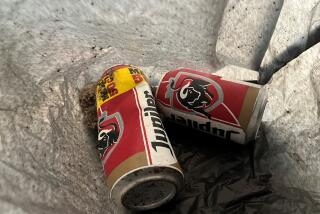Art museum’s storage bin held a secret masterwork
- Share via
Tucked away and forgotten for years in a museum storage bin, the small oil painting held a great secret and was just biding its time, waiting for someone to notice it. And then one day someone did.
So began the Case of the Curious Curator.
It all started in 2000 (actually a couple centuries earlier, but that’s getting ahead of the story) when a canvas in dreadful condition called “Venice: The Molo from the Bacino di S. Marco” was bequeathed to the Denver Art Museum from a deceased local collector’s foundation.
The accompanying paperwork was vague and referred to it as “from the studio” of Giovanni Antonio Canal — known as Canaletto — an important Italian painter in the mid-1700s.
Because it was assumed to be a student rendering, the painting was relegated to storage. And obscurity.
Seven years later, Timothy Standring, curator of painting and sculpture at the Denver museum, ran across the piece while doing routine inventory. It was so discolored and coated in grime, he later joked, it looked as if it had been “in someone’s home who smoked Marlboros for 50 years.”
Still, there was something that caught his eye.
Maybe it was the delicate, wispy brush strokes in the ship sails, or the depth and details of the characters along the Venice seaport. Standring really looked at it for the first time. Then he got excited. No student painted this.
“I think we’ve got something here,” he said.
Over the next few years he researched Canaletto and learned that the painter was renowned for his “view” cityscapes of Venice. They were like early postcards: Aristocracy on vacation would buy the paintings to take home as souvenirs, which is why much of Canaletto’s work ended up in England and now hangs in museums there.
This painting, though, was a mystery. There was no record of it. What had he found?
Standring remained cautious, even nonchalant. When art experts visited Denver, he’d casually mention the painting, ask them to take a look and gauge the response.
Still unsure, Standring traveled to London with photos to show to Charles Beddington, one of the world’s foremost Canaletto scholars. In January 2012, Beddington agreed to come to Denver to take a look in person, wrapping the trip around a ski vacation.
“Of course you know this is a Canaletto,” Beddington pronounced, putting the last doubt to rest. He dated it about 1724, making it one of the artist’s earliest undocumented works.
And it was a mess.
The museum won a grant from the European Fine Art Fair Restoration Fund to restore the painting to Canaletto’s vision. In early 2012, that job landed in the lap of James Squires, the museum’s associate conservator of paintings.
Restoring a masterwork is tedious and painstaking labor. In museum circles restorers are called the mad scientists for their obsessive tendencies.
“It’s all about control,” Squires explained, describing the delicate balance between dissolving centuries of grime and undoing previous restoration attempts without harming the original. He even made his own Q-tips out of toothpicks and cotton. He thinks the painting was restored twice before, the last time probably in the late 1800s.
Squires put in more than 100 hours over the course of a year on the 18-by-31-inch canvas, at times up to six hours on one square inch. But as he worked, something magical happened. Yellow-gray skies turned soft blue, and as the painting was cleaned, new figures appeared.
It is unknown how much the painting is worth, but another Canaletto view painting sold in 2005 for $17 million.
“Venice: The Molo from the Bacino di S. Marco” made its public debut last month with its story displayed by its side. On a recent afternoon a small crowd gathered around it, most walking away with a smile. Apparently everyone likes a hidden treasure story.
“This just goes to show that people need to go into their basement and storage facilities,” Standring said, holding back a grin. “You just never know what you will find.”
More to Read
Sign up for Essential California
The most important California stories and recommendations in your inbox every morning.
You may occasionally receive promotional content from the Los Angeles Times.










